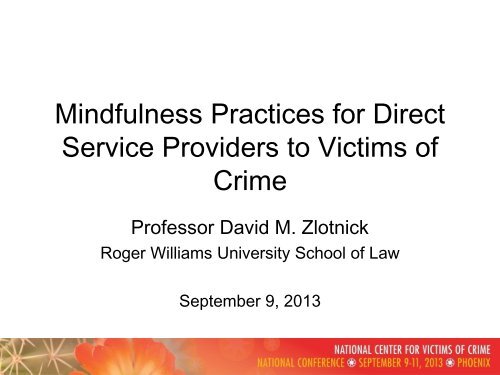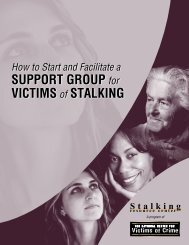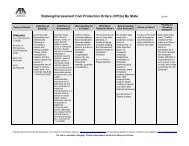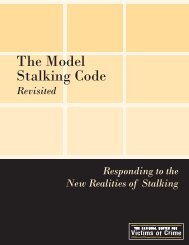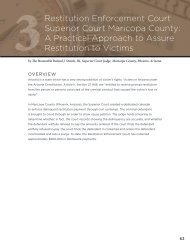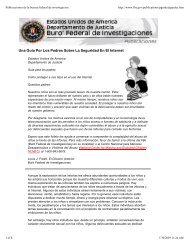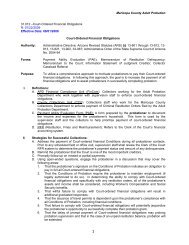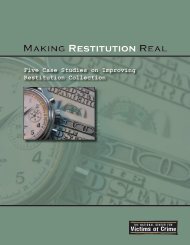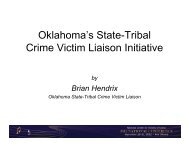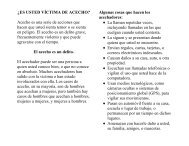Mindfulness Practices for Direct Service Providers to Victims of Crime
Mindfulness Practices for Direct Service Providers to Victims of Crime
Mindfulness Practices for Direct Service Providers to Victims of Crime
Create successful ePaper yourself
Turn your PDF publications into a flip-book with our unique Google optimized e-Paper software.
<strong>Mindfulness</strong> <strong>Practices</strong> <strong>for</strong> <strong>Direct</strong><strong>Service</strong> <strong>Providers</strong> <strong>to</strong> <strong>Victims</strong> <strong>of</strong><strong>Crime</strong>Pr<strong>of</strong>essor David M. ZlotnickRoger Williams University School <strong>of</strong> LawSeptember 9, 2013
The Emotional Challenge in Working with<strong>Crime</strong> <strong>Victims</strong>.• Bearing witness <strong>to</strong> violence, abuse, and trauma isemotionally challenging.• Having an emotional response <strong>to</strong> working with crimevictims is natural and virtually unavoidable.• But, “secondary” or “vicarious” trauma, if not dealt withskillfully, can turn in<strong>to</strong> “burnout” or even vicarioustraumatic stress disorder also known as “compassionfatigue.”• Compassion fatigue can lead <strong>to</strong> long lasting emotionalissues in your personal and pr<strong>of</strong>essional life and result inleaving the field.
Vicarious Trauma• Vicarious Trauma is a “state <strong>of</strong> tension andpreoccupation <strong>of</strong> the experiences described by clients.”• Vicarious trauma happens because you care about otherpeople who have been hurt, and feel committed orresponsible <strong>to</strong> help them. Over time this process canlead <strong>to</strong> changes in your psychological, physical, andspiritual well-being.
Exercise: Exploring Vicarious Trauma• Reflect on experience in which you felt emotional stressas a result <strong>of</strong> hearing about someone’s painfulexperience and your ef<strong>for</strong>t <strong>to</strong> be supportive.• It could be a victim, or family member or friend.• Recall the emotions, thoughts that arose as listened andtried <strong>to</strong> be helpful.• Consider both (a) your direct reactions <strong>to</strong> theirexperience AND (b) your internal response <strong>to</strong> be calledupon <strong>to</strong> be a supporter and advocate.
Exercise: The Feelings that AccompanyVicarious Trauma• Sadness• Anger• Outrage• Anxiety• Inadequacy• Frustration• Fear• Guilt• “Overwhelmed-ness”• Others?
How We Respond <strong>to</strong> Vicarious Trauma isCritical• We must recognize these symp<strong>to</strong>ms are signs <strong>of</strong> ourhumanity. If did not response this way, we wouldprobably not want <strong>to</strong> or be able <strong>to</strong> help.• What is needed are ways <strong>to</strong> experience and process thestrong emotions that arise naturally in our work. Whendone skillfully – we can avoid vicarious trauma turningin<strong>to</strong> vicarious trauma stress syndrome.
Vicarious Traumatic Stress Disorder• Decreased Energy• Disconnect (from victims, co-workers)• Numbing• Hopelessness• Cynicism• Nightmares• Changes in Appetite/Sleep• Diminished interest in Pleasurable Activities/Exercise
Distinguish “Burn Out”• “Burnout” is a more generalized syndrome characterizedby emotional exhaustion, depersonalization, and a thelack <strong>of</strong> a sense <strong>of</strong> effectiveness or achievement at work.Symp<strong>to</strong>ms <strong>of</strong> burnout can resemble vicarious traumaticstress disorder but burnout is more easily addressed bytime <strong>of</strong>f, reduction in work load, or an internal shift.
Risk Fac<strong>to</strong>rs <strong>for</strong> Vicarious Traumatic StressSyndrome• Nature <strong>of</strong> the work• Personal his<strong>to</strong>ry <strong>of</strong> trauma• Current life stresses (divorce, financial issues)• Cumulative exposure• Especially if not acknowledged or addressed.
Preventing Vicarious Traumatic Stress Syndrome:Components <strong>of</strong> a Self-Care Program• Maintaining Boundaries.• Quality Supervision/Organizational Support.• Self-Care:– Physical care (sleep, exercise, time in nature).– Psychological self care (family, community,confidents, hobbies).– Spiritual life which can include mindfulness practices.
Preventing Vicarious Traumatic StressSyndrome: Self-Care Triad• Self-care strategies can be thought <strong>of</strong> as a triad:• Escape: Getting away from it all, physically or mentally(books or films, taking time, playing video games, talking<strong>to</strong> friends about things other than work);• Rest: Having no goal or time-line, or doing things youfind relaxing (lying on the grass watching the clouds,getting a massage);• Play: Engaging in activities that make you laugh orlighten your spirits (playing with a child, being creative,being physically active).
<strong>Mindfulness</strong>: Definition• <strong>Mindfulness</strong> is described as a non-judgmental, metacognitivestate in which a person becomes very aware <strong>of</strong>their thoughts, surrounding, and feelings and attempts <strong>to</strong>experience all stimuli without judgment and withoutrelating the stimuli <strong>to</strong> the past or the future.• <strong>Mindfulness</strong> builds the capacity <strong>to</strong> sustain moment-bymomentfocused awareness <strong>of</strong>, and <strong>to</strong>, one’s internalexperience and immediate environment.
Use <strong>of</strong> <strong>Mindfulness</strong> <strong>Practices</strong> <strong>for</strong> <strong>Direct</strong><strong>Service</strong> <strong>Providers</strong>• With <strong>Victims</strong> (requires training and supervision).– <strong>Mindfulness</strong> enables capacity <strong>for</strong> sustained presence andcompassion and enhances qualities such as listening, warmth,equanimity, openness, and affect <strong>to</strong>lerance.• With Yourself (as a “daily” practice or in the moment).– <strong>Mindfulness</strong> with clients is like “putting on your oxygen maskfirst” on a plane.– <strong>Mindfulness</strong> helps you “hold your space” when confronted withtrauma. <strong>Mindfulness</strong> is like a container <strong>to</strong> holds the trauma butyou do not fall in<strong>to</strong> it.
<strong>Mindfulness</strong>: Staying Present with <strong>Victims</strong>• The goal <strong>of</strong> service providers is <strong>to</strong> help. To help, you have <strong>to</strong> bepresent. Do not underestimate human desire <strong>to</strong> flee that which isscary and unpleasant.• When we flee the present moment, we become “mindless.”– Mindlessness is a state <strong>of</strong> rigidity in which one adheres <strong>to</strong> a single perspectiveand acts au<strong>to</strong>matically. When mindless, we are reactive, unaware <strong>of</strong> our ownemotions, how we appear <strong>to</strong> others, because we are not aware how we areinside.• When mindless, we cannot be fully present and helpful as witness,caretaker, supporter, and friend. Meditation Techniques <strong>for</strong> BeingPresent include concentration on the breathe, visual (candle), andmantra practices.
“Mindful” Compassion• “If you want others <strong>to</strong> be happy, practicecompassion. If you want <strong>to</strong> be happy, practicecompassion.” Dalai Lama (2009).• Caring about a victim makes a difference. But, faced with the pain <strong>of</strong>others, we can get overwhelmed or over-identify with the victim orresult, or internally flee by distancing and shutting down emotionally.<strong>Mindfulness</strong> practices can help find a balance between these twoextremes by building compassion.•• “Mindful Compassion” has been defined at “non-judgmentalawareness and appreciation <strong>of</strong> the predicament and suffering <strong>of</strong>others (and oneself) with the felt desire <strong>to</strong> relieve suffering andincrease well-being.”
<strong>Mindfulness</strong> Practice: Being Present withDifficult Situations by Saying “Yes”• Noticing & Counting Breathes.• Friendliness <strong>to</strong>wards Distraction.• Recall a Difficult Situation (perhaps same one as be<strong>for</strong>e).– Get in <strong>to</strong>uch with charged essence <strong>of</strong> situation (scene, words,self-belief).– Locate in the body.• Send a stream <strong>of</strong> “NO” <strong>to</strong> these feelings/beliefs.• Explore your reaction <strong>to</strong> resistance <strong>to</strong> what is. Pause and breathe 3x• Say “Yes” <strong>to</strong> this situation and feelings and belief.• Repeat a stream <strong>of</strong> gentle “yes” and observe.
<strong>Mindfulness</strong> <strong>Practices</strong>: Evoking Compassionin Difficult Situations• Reflect on your intention that victims have more peace in their lives.• Bring one victim <strong>to</strong> mind – feel what they feel w/o getting caught up.Recognize that in life there is pain and suffering.• Reflect that hurting after trauma is part <strong>of</strong> being alive & recovery.• Remember that everything is impermanent, everything changes,even this person’s suffering will change, lessen, even depart.• Your job is not <strong>to</strong> save this victim but <strong>to</strong> be present with compassion.• Vow only <strong>to</strong> do the best you can do <strong>to</strong>day.• Experience gratitude <strong>for</strong> this opportunity <strong>to</strong> help.• Because we are all connected.• And every moment is precious, even this one.
More on Mindful Compassion• Meditation helps compassion grow because it canreduce interference from personal his<strong>to</strong>ry, culturalbaggage, and egocentric need.• Meditation promotes a recognition <strong>of</strong> “non-duality” – thatwe are all inextricably coexistent.• Specific meditation practices <strong>to</strong> build compassion:– “Loving Kindness” meditation (send love and peace <strong>to</strong> self andwidening circle).– “ Tonglen” – Giving and Receiving (breathe in and breathe outpain <strong>of</strong> others).
Mindful Self-Debriefing• After a troubling/upsetting meeting with a victim, takesome <strong>to</strong> time <strong>to</strong> do a mindful self-debriefing:• What are some sad/upsetting things I learned about thisvictim’s life or circumstances?• When I bring my mind <strong>to</strong> this victim and his/her life, Ithink:______________________________________.• When I think about these things, Ifeel:_______________________________________.• As these feelings arise, I notice sensations in thefollowing areas <strong>of</strong> my body: ______________________.
R.A.I.N. – The Gold Standard Practice <strong>for</strong>Working with Difficulty• R Recognize what is happening• A Allow life <strong>to</strong> be just as it is• I Investigate inner experience with kindness• N Non-Identification.• RAIN directly de-conditions the habitual ways in which you resistyour moment-<strong>to</strong>-moment experience. It doesn’t matter whether youresist “what is” by lashing out in anger, by having a cigarette, or bygetting immersed in obsessive thinking. Your attempt <strong>to</strong> control thelife within and around you actually cuts you <strong>of</strong>f from your own heartand from this living world. RAIN begins <strong>to</strong> undo these unconsciouspatterns as soon as we take the first step.•
RAIN: Recognize• Recognize what is happening.– Recognition is seeing what is true in your inner life. It starts theminute you focus your attention on whatever thoughts, emotions,feelings or sensations are arising right here and now. Someparts <strong>of</strong> your experience are easier <strong>to</strong> connect with than others.You might recognize anxiety right away, but might not notice theactual sensations <strong>of</strong> tightness arising in the body. On the otherhand, if your body is gripped by jittery nervousness, you mightnot recognize that this physical response is being triggered byyour underlying belief that you are about <strong>to</strong> fail. You can awakenrecognition simply by asking: “What is happening inside me rightnow?” Try <strong>to</strong> let go <strong>of</strong> any preconceived ideas.
• Allow Life <strong>to</strong> Be:RAIN: Allow Life <strong>to</strong> Be.– Allowing means “letting be” the thoughts, emotions, feelings orsensations you discover. You may feel a natural sense <strong>of</strong>aversion, <strong>of</strong> wishing that unpleasant feelings would go away, butas you become more willing <strong>to</strong> be present with “what is,” adifferent quality <strong>of</strong> attention will emerge. Similar <strong>to</strong> the “YES”meditation.– It can be helpful <strong>to</strong> whispering an encouraging word or phraselike “yes” or “this <strong>to</strong>o” or “I consent.” At first you might feel you’rejust “putting up” with unpleasant emotions or sensations. Or youmight say “yes” <strong>to</strong> shame and hope that it will magicallydisappear. In reality, we have <strong>to</strong> consent again and again. Offerthe phrase gently and patiently, and in time your defenses willrelax, and you may feel a physical sense <strong>of</strong> yielding or opening<strong>to</strong> waves <strong>of</strong> experience.
RAIN: Investigate with Kindness• Investigation with Kindness:– Sometimes, the first two steps are enough <strong>to</strong> provide relief. In the thick <strong>of</strong> things,you may be easily overwhelmed by intense feelings and triggered over and overagain. Here, you may need <strong>to</strong> strengthen mindful awareness a more focusedattention <strong>to</strong> your present experience. With investigation you engage in a moreactive and pointed kind <strong>of</strong> inquiry. You might ask yourself: “What most wantsattention?” “How am I experiencing this in my body?” or “What am I believing?”or “What does this feeling want from me?” You might contact sensations <strong>of</strong>hollowness or shakiness, and then find a sense <strong>of</strong> unworthiness and shameburied in these feelings. Unless they are brought in<strong>to</strong> consciousness, thesebeliefs and emotions will control your experience and perpetuate youridentification with a limited, deficient self. To avoid causing more harm, you need<strong>to</strong> <strong>of</strong>fer a gentle welcome <strong>to</strong> whatever surfaces as if a small child was asking you<strong>for</strong> help with a problem at school.
RAIN: Non-Identification• Realize Non-identification; Rest in Natural Awareness.– The lucid, open and kind presence evoked in the R, A and I <strong>of</strong>RAIN leads <strong>to</strong> the N: the freedom <strong>of</strong> Non-identification, and therealization Natural awareness or natural presence. Nonidentificationmeans that your sense <strong>of</strong> who you are is not fusedwith or defined by any limited set <strong>of</strong> emotions, sensations ors<strong>to</strong>ries. When identification with the small self is loosened, webegin <strong>to</strong> intuit and live from the openness and love that expressour natural awareness. The first three steps <strong>of</strong> RAIN requiresome intentional activity. In contrast, the N <strong>of</strong> RAIN expressesthe result: a liberating realization <strong>of</strong> your natural awareness.There’s nothing <strong>to</strong> do <strong>for</strong> this last part <strong>of</strong> RAIN—realizationarises spontaneously, on its own. We simply rest in naturalawareness.
Another Minute <strong>of</strong> <strong>Mindfulness</strong>• Rest in Awareness/Count Breathes• The past is nothing but memories,• The future is nothing but plans,• The only thing real is this moment.


